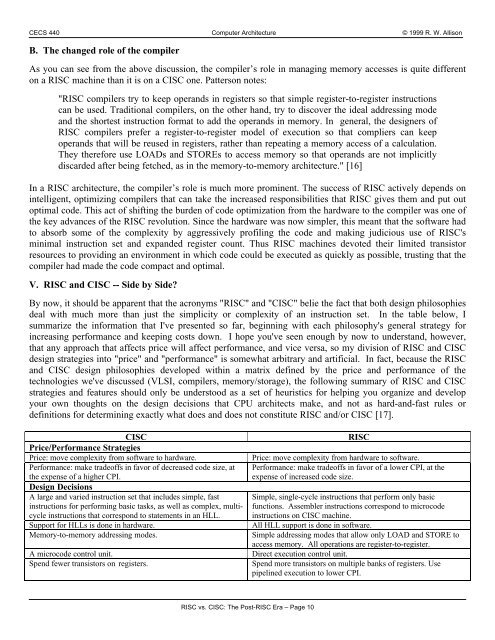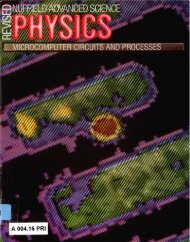RISC vs. CISC
RISC vs. CISC
RISC vs. CISC
Create successful ePaper yourself
Turn your PDF publications into a flip-book with our unique Google optimized e-Paper software.
CECS 440 Computer Architecture © 1999 R. W. Allison<br />
B. The changed role of the compiler<br />
As you can see from the above discussion, the compiler’s role in managing memory accesses is quite different<br />
on a <strong>RISC</strong> machine than it is on a <strong>CISC</strong> one. Patterson notes:<br />
"<strong>RISC</strong> compilers try to keep operands in registers so that simple register-to-register instructions<br />
can be used. Traditional compilers, on the other hand, try to discover the ideal addressing mode<br />
and the shortest instruction format to add the operands in memory. In general, the designers of<br />
<strong>RISC</strong> compilers prefer a register-to-register model of execution so that compliers can keep<br />
operands that will be reused in registers, rather than repeating a memory access of a calculation.<br />
They therefore use LOADs and STOREs to access memory so that operands are not implicitly<br />
discarded after being fetched, as in the memory-to-memory architecture." [16]<br />
In a <strong>RISC</strong> architecture, the compiler’s role is much more prominent. The success of <strong>RISC</strong> actively depends on<br />
intelligent, optimizing compilers that can take the increased responsibilities that <strong>RISC</strong> gives them and put out<br />
optimal code. This act of shifting the burden of code optimization from the hardware to the compiler was one of<br />
the key advances of the <strong>RISC</strong> revolution. Since the hardware was now simpler, this meant that the software had<br />
to absorb some of the complexity by aggressively profiling the code and making judicious use of <strong>RISC</strong>'s<br />
minimal instruction set and expanded register count. Thus <strong>RISC</strong> machines devoted their limited transistor<br />
resources to providing an environment in which code could be executed as quickly as possible, trusting that the<br />
compiler had made the code compact and optimal.<br />
V. <strong>RISC</strong> and <strong>CISC</strong> -- Side by Side?<br />
By now, it should be apparent that the acronyms "<strong>RISC</strong>" and "<strong>CISC</strong>" belie the fact that both design philosophies<br />
deal with much more than just the simplicity or complexity of an instruction set. In the table below, I<br />
summarize the information that I've presented so far, beginning with each philosophy's general strategy for<br />
increasing performance and keeping costs down. I hope you've seen enough by now to understand, however,<br />
that any approach that affects price will affect performance, and vice versa, so my division of <strong>RISC</strong> and <strong>CISC</strong><br />
design strategies into "price" and "performance" is somewhat arbitrary and artificial. In fact, because the <strong>RISC</strong><br />
and <strong>CISC</strong> design philosophies developed within a matrix defined by the price and performance of the<br />
technologies we've discussed (VLSI, compilers, memory/storage), the following summary of <strong>RISC</strong> and <strong>CISC</strong><br />
strategies and features should only be understood as a set of heuristics for helping you organize and develop<br />
your own thoughts on the design decisions that CPU architects make, and not as hard-and-fast rules or<br />
definitions for determining exactly what does and does not constitute <strong>RISC</strong> and/or <strong>CISC</strong> [17].<br />
<strong>CISC</strong><br />
Price/Performance Strategies<br />
<strong>RISC</strong><br />
Price: move complexity from software to hardware. Price: move complexity from hardware to software.<br />
Performance: make tradeoffs in favor of decreased code size, at Performance: make tradeoffs in favor of a lower CPI, at the<br />
the expense of a higher CPI.<br />
Design Decisions<br />
expense of increased code size.<br />
A large and varied instruction set that includes simple, fast Simple, single-cycle instructions that perform only basic<br />
instructions for performing basic tasks, as well as complex, multi- functions. Assembler instructions correspond to microcode<br />
cycle instructions that correspond to statements in an HLL. instructions on <strong>CISC</strong> machine.<br />
Support for HLLs is done in hardware. All HLL support is done in software.<br />
Memory-to-memory addressing modes. Simple addressing modes that allow only LOAD and STORE to<br />
access memory. All operations are register-to-register.<br />
A microcode control unit. Direct execution control unit.<br />
Spend fewer transistors on registers. Spend more transistors on multiple banks of registers. Use<br />
pipelined execution to lower CPI.<br />
<strong>RISC</strong> <strong>vs</strong>. <strong>CISC</strong>: The Post-<strong>RISC</strong> Era – Page 10











